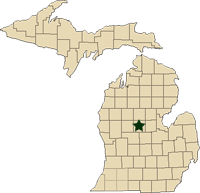Regional reports on Michigan field crops – June 2, 2011
MSU Extension educators’ pest and field crop updates for Michigan.
This week’s regional reports:
- Southeast Michigan – Ned Birkey
- West Central Michigan – Fred Springborn
- Central Michigan – Paul Gross
Southeast Michigan – Ned Birkey, Michigan State University Extension
|
Weather has been hot with storms on Sunday (May 29), but has turned milder and with no rain since. I had 4.5 inches of rain at my place in the five days from Wednesday (May 25) through Sunday. Many fields remain too wet too work as all the drier fields have already been planted. Soils are deceptively dry on top and wet underneath. Yesterday (June 1), with high winds, there were some sandier fields with substantial soil blowing across US-23. However, there is still a lot of soil moisture beneath the soil surface.
Alfalfa should be cut once the soils dry out beneath a heavy stand. Potato leafhoppers have arrived, but will not be a factor in the quality of the first cutting.
Corn that has been planted, and is not underwater, is at the V2-V3 leaf stage. The wetter fields remain to be planted. Weed control and sidedress nitrogen applications will be made soon.
Soybean planting should continue in select wetter fields starting today. Bean leaf beetles have been reported feeding on young soybean plants. It is difficult to get over threshold for an entire field. Weed control is a major issue in fields yet to be planted. Most of these fields are being tilled up prior to planting, which is delaying planting.
Wheat is heading out, with many fields at Feekes’ growth stage 10.5.1 and a few fields are beginning flowering. Now is the last time to apply fungicides to protect the heads from Fusarium head scab. Farmers need to watch the label to see if the product they use has a 30 day pre-harvest restriction.
West Central Michigan – Fred Springborn, Michigan State University Extension
|
Wet weather continues in much of the west central region, hindering and delaying field work in many areas. Standing water is common in low areas of fields and on poorly drained soils. Low soil temperatures are in the mid to upper 50s to low 60s. High air temperatures have ranged from the mid-80s on Monday (May 30) and Tuesday, to the mid-50s to low 60s last Thursday (May 26) and Friday.
|
|
Corn growth stage ranges from still in the bag to V4. Condition of the crop that is planted ranges from excellent to fair at best. Some fields were planted when soils were quite wet and have remained wet, and seedlings are oxygen-starved. Overall, 75 to 80 percent of corn is planted. Several growers are now finished planting or are switching to other crops, a number of corn growers have very little planted and will continue planting this week.
Alfalfa is growing quite well with many fields over 28 inches in height with buds forming. Harvest has begun where soil conditions will allow. Alfalfa weevil larvae and low levels of damage have been observed. Potato leafhopper adults are just starting to appear at low levels.
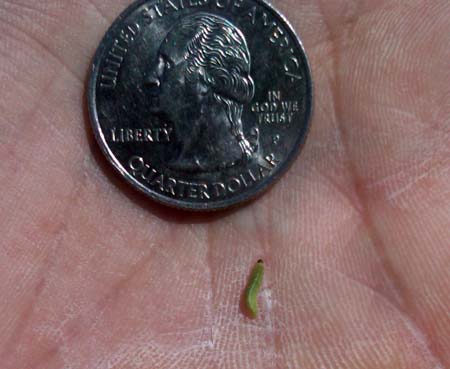
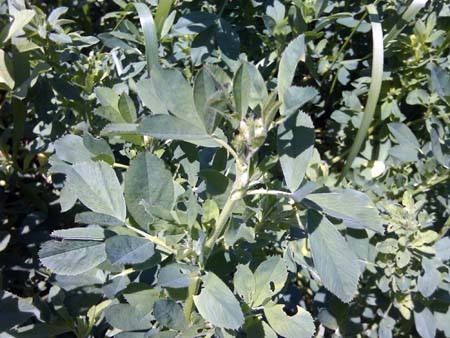
Left, alfalfa weevil larva. Right, alfalfa weevil damage.
Wheat is at Feekes’ 10 to 10.2 and variable. With full heading and flowering close at hand, I encourage all growers to access wheat fields and be prepared to make a fungicide application to fields that warrant it. If fungicide application will be made with a ground rig, check the fields first for washout areas that may pose a hazard to the ground rig and operator. Foliar disease pressure has increased in many varieties, and powdery mildew is commonly observed. The primary concern will be head scab.
Soybean planting is underway and several fields are now emerging.
Potato planting is approximately 70 to 75 percent complete. Volunteer potatoes are continuing to emerge in many corn fields. Colorado potato beetle adults have emerged.
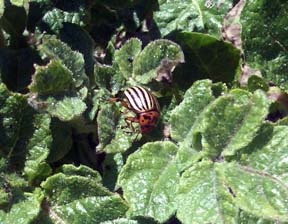
Colorado potato beetle adult on volunteer potato.
Central Michigan – Paul Gross, Michigan State University Extension
|
Weather
Planting has resumed after a week of mixed and turbulent weather that included heavy rains, hail and high winds. The southern parts of the region received more rain than the northern portion and field activities reflect rain totals. Planting conditions are marginal at best, but farmers are going where they can in hopes of getting the crops planted in the window of nice weather that is predicted. With the windy conditions, farmers are cautioned about herbicide drift.
Commodity reports
Corn is a tale of two crops. The early planted fields have emerged and the stands are very good. The fields that have not been planted are weedy and will be planted in less than ideal conditions. This year, the challenge will be the poor planting conditions and the impact it will have on the crop later in the season. Some of the compaction problems may be with us for years to come. Manage weeds as soon as possible.
Soybean planting is progressing where field conditions allow. The early planted fields are doing very well and the first trifoliate leaves are emerging. Scout fields for disease and insect problems. Manage weeds as soon as possible.
The wheat crop is just starting to head. We are nearing the time to apply fungicides for Fusarium. It will be important that farmers monitor fields for proper growth stage and time the fungicide application for maximum efficacy. With the wet field conditions, the higher rates of fungicides should be used. Yield potential is very good and that yield should be protected.
Alfalfa harvest is just getting underway. Alfalfa has reached PEAQ 40 NDF. No report of insect problems at this time. It has been reported that leafhopper adults are now in Michigan. Fields are wet so farmers are harvesting with caution.
Oats and barley look very good. Weed control will be necessary very soon as the weeds are growing rapidly and will be past the size for optimum control. There are a few farms that are still trying to get oats planted.



 Print
Print Email
Email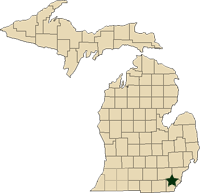
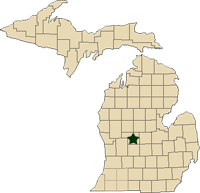
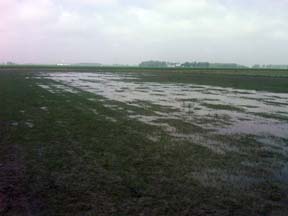 Standing water in fields.
Standing water in fields.